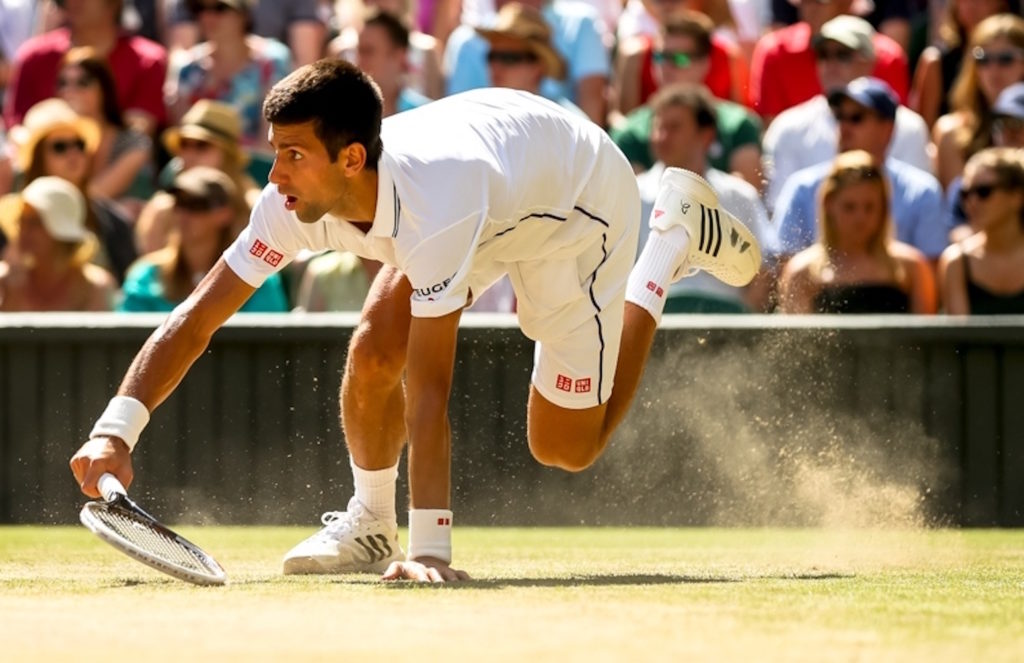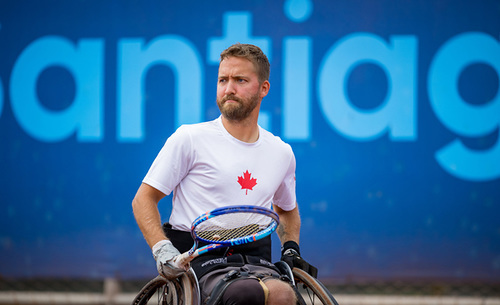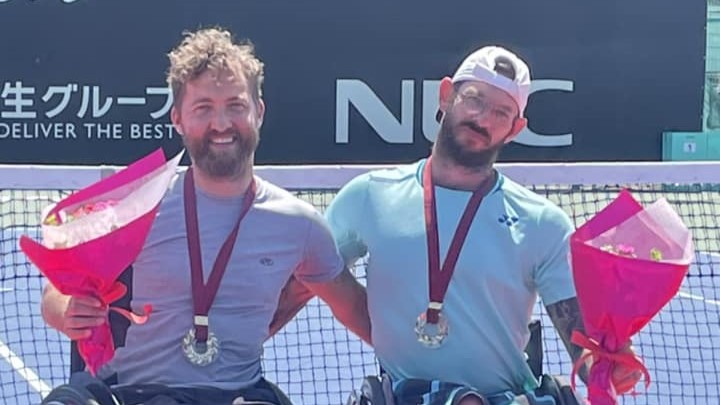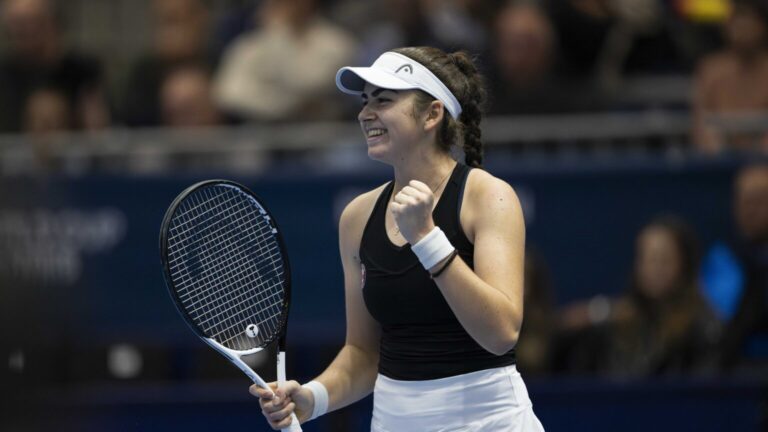
When Roger Federer played Taylor Fritz last Tuesday on grass in Stuttgart, it was a different kind of tennis than the one seen the previous two weeks on clay at Roland Garros. Mainly it was about the serve – and if it wasn’t about the serve it was usually about the first shot following the serve, most of the time an aggressively hit forehand.
There was some to and fro in the rallies but little of the lengthy probing that went on in Paris on the terre battue. It was all about the big strike.
But still, that’s not the way tennis generally is on grass nowadays. Things have changed over the past two decades, from 1998 when the Wimbledon final between Pete Sampras and Goran Ivanisevic featured a longest rally just lasting seven, yes seven, strokes. Fast forward to 2016 and the vast majority of players conduct their business from the baseline. The distinctive mushroom-shaped wear pattern on the court – where players move forward after serving and flare out right or left at the service line to volley – has been replaced by a wide scruffy patch inside and outside the baseline.

Grass courts (above a Hawk-Eye crew preparing Court 18 last year) at Wimbledon and Queen’s Club in London have evolved over the years and a combination of a more clay-based topsoil (making the surface harder) and more durable blends of grass have created greater resistance, preventing the ball from shooting through as fast or as low as in the past.
Wimbledon uses 100 per cent rye grass and reseeds its courts every year while Queen’s Club does not reseed but uses a blend of 50 per cent rye, 45 per cent two types of fescue and five per cent bent grass.
No matter what, big servers like Milos Raonic, Ivo Karlovic and John Isner are still going to get more reward for their efforts because grass will never create as much friction as a clay or hard court.
 In an era when many players, and even more old-timers, complain about the slowness of most courts, modern grass courts still provide a useful reward for well-struck or well-sliced balls – and overall for attacking games from the baseline or at the net.
In an era when many players, and even more old-timers, complain about the slowness of most courts, modern grass courts still provide a useful reward for well-struck or well-sliced balls – and overall for attacking games from the baseline or at the net.
Precipitation is the curse of all groundskeepers. But in London the crews are adept at getting the covers on quickly. Graham Kimpton (on the left) is the grounds manager at Queen’s Club where this week’s Aegon Championships are taking place. With two crew members dedicated to getting the umpire’s chair out of the way and two more responsible for the net-posts, his crew can cover the court in as little as 30 seconds.
Closer to home, a tennis enthusiast in the Toronto area has built several grass courts on a property north of the city. The top dressing is sandy loam. It drains well and can be ready for play in 30 minutes after a rainfall if the sun comes out. The courts, according to the owner, have a bounce as good as a hard court when they’re firm.

If the space is available, a grass court can be much cheaper than a hard court or a clay court to build. The catch of course is that the courts in the picture above are only available for play from June until late August. Once the temperature starts dropping at night there gets to be too much dew on the courts, making maintaining the surface problematical.
Still, there’s a mythical quality about the courts and this particularly enthusiast claims it’s his “hobby.” He grew up playing on grass in England and said, “I think it’s romantic. Grass was the original surface for tennis and any true tennis player, if they get a chance, should play on grass.”
And there’s something that compensates for the short season. “This is a nice time of year for grass,” he explained this week. “It says that summer is here. It evokes the pageantry and colour of Wimbledon and is aesthetically pleasing. It gives you a sense of enthusiasm. It’s an emotional thing.”
The Sharapova sanction

Maria Sharapova has been a consummate professional among the current group of elite WTA players. While some people may not like her being aloof among her peers and others detest her grunting, there’s no disputing she has conducted herself with the media in a respectful, thoughtful manner, always given a 100 per cent effort on court and been a gracious loser.
Despite an image all about glamour and lucrative endorsement contracts, she has essentially been a ‘gym-rat’ kind of player – she loves her sport and has always been willing to put in the work required. That has been rewarded with holding the WTA No. 1 ranking for a total of 21 weeks and winning five Grand Slam titles, including each one at least once.
Sharapova, who first won Wimbledon at 17 in 2004 and turned 29 this past April 19th, has always been committed to her profession and demanding of those working with her. In 2008 a shoulder problem forced her to withdraw from Rogers Cup in Montreal after her opening-round in late July and she didn’t return to action until the Warsaw tournament the following May. She had surgery in October 2008, for two significant rotator cuff tears, the severity of which she and her team downplayed.
She eventually made a comeback, winning two more Grand Slam titles – the French Open in 2012 and 2014 – despite the repaired shoulder not allowing her the same free-wheeling service motion she had pre-surgery.
When she returned, she was critical of more than one misdiagnosis by doctors before the nature of the injury was determined and resolved by an operation.
That reaction was noteworthy because she expected more of the doctors who examined her, much in the same way many people learning of her current positive drug test situation would have expected more from her.
To have been taking meldonium (brand name Mildronate) for more than 10 years and not to have reported it on drug forms filled out in 2014 and 2015 was certainly troubling for the Independent Tribunal appointed by the 2016 Tennis Anti-Doping Programme examining her case.
It was hard to believe that a drug she took before all of her five matches at the 2016 Australian Open (as well as on many other occasions including six times in seven days at last year’s Wimbledon) would not be noted on the forms.
Maybe most concerning was that she had not informed any of her support team and that only her agent Max Eisenbud and her father Yuri knew that she was taking meldonium after she switched doctors from the original one who prescribed it in 2006.
That means her coach Sven Groeneveld, her fitness trainer and her physio were not aware she was using the drug. So there was no way they could have thought to verify whether meldonium had become a banned substance effective January 1, 2016.
It was interesting that, after her public announcement on March 7 in Los Angeles that she had tested positive, several players, including world No. 3 Agnieszka Radwanska, revealed during the BNP Paribas Open in Indian Wells that they usually did not read the International Tennis Federation notices of banned substances, instead relied on their support teams to do so.
The Independent Tribunal wrote in its decision, “her concealment from the anti-doping authorities and her team of the fact that she was regularly using Mildronate in competition for performance enhancement was a very serious breach of her duty to comply with the rules.
“Her conduct was serious in terms of her moral fault and significant in its causative effect on the contravention. If she had been open with the anti-doping authorities, her team or the doctors she consulted, then the probability is that she would have been warned of the change to the Prohibited List and avoided a contravention.”
 Sharapova’s legal representatives argued for a lesser penalty than the two-year suspension based on some of the particulars of her case, including her coming forward to admit she had taken the drug and being co-operative and candid in giving the background information of her meldonium use. But the Tribunal was not swayed. “The rules cannot be circumvented by invoking the principle of proportionality,” it wrote. “It would be contrary to the principles underlying the code, in particular respect for the rules which must apply equally to all, to allow an unprincipled exception to or waiver from the rules on the grounds of proportionality of sanction as it affects the particular circumstances of this player.”
Sharapova’s legal representatives argued for a lesser penalty than the two-year suspension based on some of the particulars of her case, including her coming forward to admit she had taken the drug and being co-operative and candid in giving the background information of her meldonium use. But the Tribunal was not swayed. “The rules cannot be circumvented by invoking the principle of proportionality,” it wrote. “It would be contrary to the principles underlying the code, in particular respect for the rules which must apply equally to all, to allow an unprincipled exception to or waiver from the rules on the grounds of proportionality of sanction as it affects the particular circumstances of this player.”
So Sharapova is banned for two years, pending her appeal to the Court of Arbitration for Sport (CAS) in Lausanne, Switzerland. CAS has announced it will make a ruling by July 18.
If the suspension is shortened, maybe to a year or 15 months, Sharapova would not be eligible to return until after the 2017 Australian Open but before next year’s French Open.
It’s possible to imagine she could come back and again be a significant player on the WTA circuit. But if the two-year ban is upheld, it’s tough to see her being a factor at age 31 when she would next play a Grand Slam at Roland Garros in May 2018.
In light of Sharapova’s meticulous conduct in so many areas of her career – following her October 2008 surgery, she spent month after month commuting for five days a week from her Los Angeles home to Scottsdale, Arizona, for rehab – it’s hard to believe she has jeopardized her future with such an elementary oversight.
Sadly, despite the fact that Sharapova has been a solid citizen of the tennis world for so long, it’s hard not to agree with the Tribunal’s ultimate conclusion – “She is the sole author of her own misfortune.”
Bouchard with Mallorca win

Playing in the quaint confines of the new centre court at the Tennis Club Santa Ponsa in Calvia, Genie Bouchard won her opening match at the Mallorca Open on Tuesday, defeating Danka Kovinic of Montenegro 6-3, 7-5.
Calvia is located on the opposite side of the Balearic island from Rafael Nadal’s hometown of Manacor.
Bouchard started well against the No. 53-ranked Kovinic, taking a 3-0 lead and maintaining control to take the opening set. The second set was a different story as her hard-hitting opponent sharpened her game and grabbed a 5-2 lead. At that point Kovinic began to misfire a little more often and Bouchard was opportunistic – going on a five-game run that she finished off with an ace on her second match point.
Bouchard won more points than her 21-year-old opponent (76-57) but was only 3/11 on break points compared to 1/1 for Kovinic.
The victory sets up a fascinating second-round match for the No. 47-ranked Montrealer – she will face Anastasija Sevastova of Latvia. The 26-year-old started the year at No. 110 and is now up to No. 86.
Bouchard leads their head-to-head 1-0 but it was a mighty struggle in the first round of the Premier 5 event in Doha in February – final score 5-7, 6-3, 7-6(4).
Milos talks grass tennis
Milos Raonic spoke on the ATP World Tour website about his 2016 grass-court plans, consulting coach John McEnroe and Wimbledon.
Graphic insight
You're right. These are rankings of #Djokovic, #Nadal, #Federer opponents when he won first 12 GS. pic.twitter.com/2NARfecnnJ
— Tom Djurdjevich (@TomDjurdjevich) June 13, 2016
Here’s a look at the rankings of the opponents that Roger Federer, Rafael Nadal and Novak Djokovic played in their respective first 12 Grand Slam finals. It’s fodder for those arguing the merits of the biggest three of the so-called Big Four.
—
Feature photo: Mauricio Paiz


